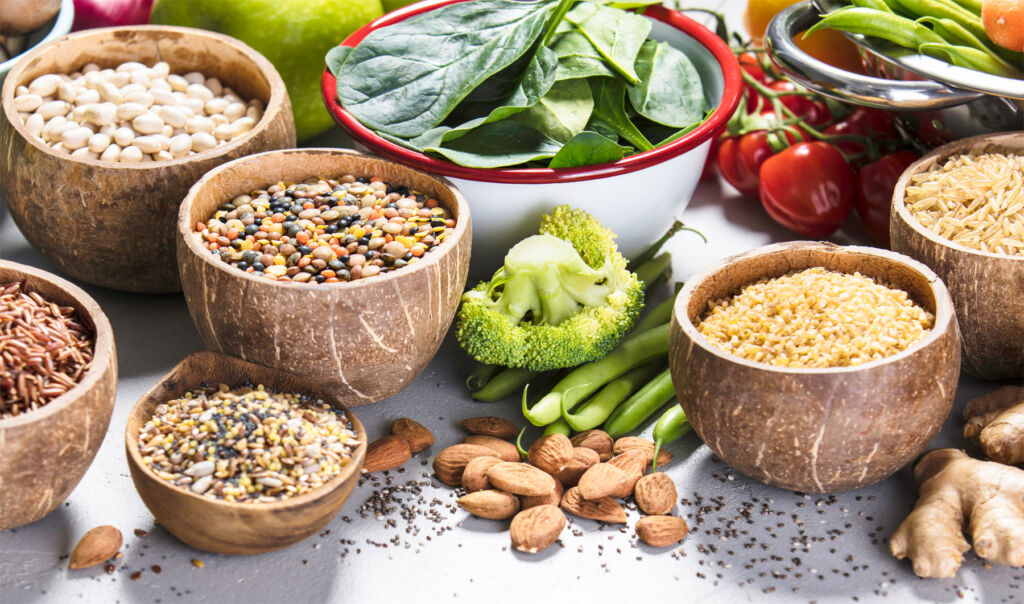
Over half of Brits say they’re overweight, yet national fibre intake levels languish at around two-thirds of what they should be, despite mounting scientific evidence that eating more fibre is beneficial for healthy body weight.
The above is according to a new report based on a consumer survey of over 1000 British adults aged 18 to 75+, entitled “Going against the grain,” [1] which lays out the huge health consequences of the great British fibre gap while providing a simple and effective solution.
“This new report conducted on behalf of General Mills, maker of brands like Fibre One and based on UK dietary intake data[2] tells us that Brits are missing out on a third of the dietary fibre they should be consuming if they want to live long and healthy lives,” says dietitian Dr Carrie Ruxton.
So, is fibre the weight loss magic ingredient that’s been hiding in plain sight?
Regarding people’s knowledge in this area, fewer than three in 10 (28%) polled said they were confident that eating plenty of fibre is linked to weight control. The majority were not clear about the fibre-weight connection.
“Obesity is accelerating as a global public health issue, which is reflected in the survey data,” says GP Dr Binita Kalaria, adding, “Over half of respondents described themselves as ‘overweight’ – that includes 43% saying they were slightly overweight and 11% who said they were very overweight.”
“Obesity is often put down to too many calories in versus too few calories out,” says Dr Ruxton, “But the picture is more complex than that, incorporating factors such as environment, lifestyle, genetics, and underlying state of health. It’s also worth noting that a feeling of heaviness could also be related to a lack of digestive health, with over six in 10 (62%) in the survey saying they often or sometimes felt bloated.”
Despite this, only a quarter of survey respondents said calorie control was among their top diet goals. Instead, the greatest priority – noted by almost half of adults – was eating less sugar, while the next was cutting down on fat.
Fewer than a quarter prioritised eating more fibre, despite it being the lowest calorie nutrient– just two calories per gram[3] – compared with fat (9 calories per gram) or alcohol (7 calories per gram).
“Indeed, a leading reason for our Great British fibre fail, according to the Fibre One survey, is that people are not keeping fibre front of mind when doing their food shop,” says Dr Ruxton, adding, “It’s likely that the advice to boost fibre is getting lost amid much louder messaging to reduce sugar, fat, and salt in the diet.”
And yet fibre is easy and generally inexpensive to source. “Fibre is simply natural plant material that our bodies can’t digest,” says Dr Ruxton, adding: “Commonly available sources include whole grain cereals, beans and pulses, fruits and vegetables, skin-on potatoes, nuts and seeds, and fibre-enriched food products, such as those containing oligofructose, inulin, or psyllium.”
Scientific evidence supports fibre’s weight-shedding properties. For instance, Dr Kalaria mentions a recent ‘super study’, a meta-analysis of high-quality studies in the journal Nutrients,[4] which found that overweight and obese people lost significantly more weight when topped up with fibre compared with a control diet.
The researchers also saw significant reductions in waist circumference and control of blood sugars and insulin with the fibre-supplemented diet.
Helping people to feel full after eating, known as satiety, maybe the main way that fibre helps with weight management, according to a study from the International Association for the Study of Obesity.[5] This was correctly identified by four in 10 (42%) of survey respondents, who were confident that fibre could help them feel fuller after eating.
In fact, another ‘super study’ in the journal Foods showed that soluble fibre, in particular, slows stomach emptying, increases perceived satiety, and significantly impacts appetite control[6].
Dr Kalaria explains: “Soluble fibre expands and forms a gel when it’s mixed with water in the gut. This helps to boost feelings of fullness after eating. That’s why fruit and vegetables – which are all rich in soluble fibre – are a good choice for filling up when you’re trying to manage your weight”.
Another benefit of soluble fibre is that it’s fermented by ‘good’ bacteria living in the colon, which go on to release short-chain fatty acids. These compounds regulate hormones, which boost feelings of fullness and reduce appetite[7].
“There is no weight loss magic bullet, I’m afraid, but dietary fibre shows promise as part of a multi-pronged approach to helping people maintain a healthy body weight,” says Dr Kalaria.
She adds, “Experts must answer the call and actively encourage fibre consumption, as most survey respondents said they would be more likely to eat high-fibre foods if a health professional said it would help them manage their weight.”

Expert tips to fill up on fibre
Dietitian Dr Carrie Ruxton and GP Dr Binita Kalaria understand the importance of meeting fibre recommendations when it comes to maintaining a healthy body weight. Here, they offer seven tasty tips to help Brits up their intakes.
Take sides: “Plan to add a side of veg or salad to every main meal. This is a great way to get more fibre as well as other essential vitamins and minerals without having to think too hard about it. In no time, you could be upping your daily veg portions by three a day.” says Dr Kalaria.
Mix and match: “Don’t bore your tastebuds with the same breakfast every day. Look forward to higher fibre options by changing up the type of loaf you buy each week and the type of high-fibre cereal you stock up on. And why not add a serving of fresh or frozen fruit, too?” says Dr Ruxton.
Switch it up: “If you’re used to white bread, pasta, and rice, ease yourself in gently. Start by swapping white bread for half and half, and gradually move to whole grain varieties. Where pasta is concerned, besides regular wholegrain, there’s a huge variety of different types to try, from chickpea to lentil to buckwheat.” says Dr Kalaria.
Add a flourish: “There are several simple ways to enhance mealtimes with high-fibre add-ons. For instance, you could top porridge with chopped nuts and dried fruits or dress up a salad with colourful roasted veg and crunchy toasted seeds.” says Dr Ruxton.
Bean feast: “Protein is another important nutritional constituent of mealtimes. Beans are not only a good source of Protein, they are also rich in fibre. So, why not swap out some of the meat in your next batch-cooked stew, casserole, curry, or chilli with a tin of beans? Besides being beneficial to your health, it’s likely to save you money.” says Dr Kalaria.
Make snacks count: “Instead of reaching for the crisps and chocolate for a between meals pick-me-up, have a range of different vegetable sticks on hand. This could include carrots, peppers, cucumbers, celery, baby corn, and anything else you fancy.
For a real fibre boost, try dipping them in hummus or a bean-based dip. Oatcakes and nut butter of your choice is another fibre-filled and delicious way to curb hunger pangs.” says Dr Ruxton.
Drink up: “This last tip is especially important for supporting healthy fibre intake. Don’t forget that higher-fibre diets require us to drink plenty of fluids to keep things moving smoothly through the digestive system. Tap water is always the best option.” says Dr Kalaria.
References:
[1] A 2023 consumer survey of 1017 UK adults aged 18 to 75+, including 700 general population and 300 weight managers and dieters. Conducted by the Bell Institute of Health and Nutrition at General Mills. https://www.bellinstitute.com/
[2] National Diet and Nutrition Survey (2020). Results from years 9 to 11 (2016 to 2017 and 2018 to 2019). https://www.gov.uk/government/statistics/ndns-results-from-years-9-to-11-2016-to-2017-and-2018-to-2019
[3] EFSA Panel on Nutrition, Novel Foods and Food Allergens. (2022). Scientific Opinion on the scientific advice related to nutrient profiling for the development of harmonised mandatory front-of-pack nutrition labelling and the setting of nutrient profiles for restricting nutrition and health claims on foods. https://doi.org/10.2903/j.efsa.2022.7259
[4] Huwiler VV, et al. (2022). Prolonged Isolated Soluble Dietary Fibre Supplementation in Overweight and Obese Patients: A Systematic Review with Meta-Analysis of Randomised Controlled Trials. https://www.ncbi.nlm.nih.gov/pmc/articles/PMC9268533/
[5] Blundell J, et al. (2010). Appetite control: methodological aspects of the evaluation of foods. https://www.ncbi.nlm.nih.gov/pmc/articles/PMC3609405/
[6] Salleh SN, et al. (2019). Unravelling the Effects of Soluble Dietary Fibre Supplementation on Energy Intake and Perceived Satiety in Healthy Adults: Evidence from Systematic Reviews and Meta-Analysis of Randomised-Controlled Trials. https://www.ncbi.nlm.nih.gov/pmc/articles/PMC6352252/
[7] Salleh SN, et al. (2019). Unravelling the Effects of Soluble Dietary Fibre Supplementation on Energy Intake and Perceived Satiety in Healthy Adults: Evidence from Systematic Reviews and Meta-Analysis of Randomised-Controlled Trials. https://www.ncbi.nlm.nih.gov/pmc/articles/PMC6352252/
![]()




You must be logged in to post a comment.